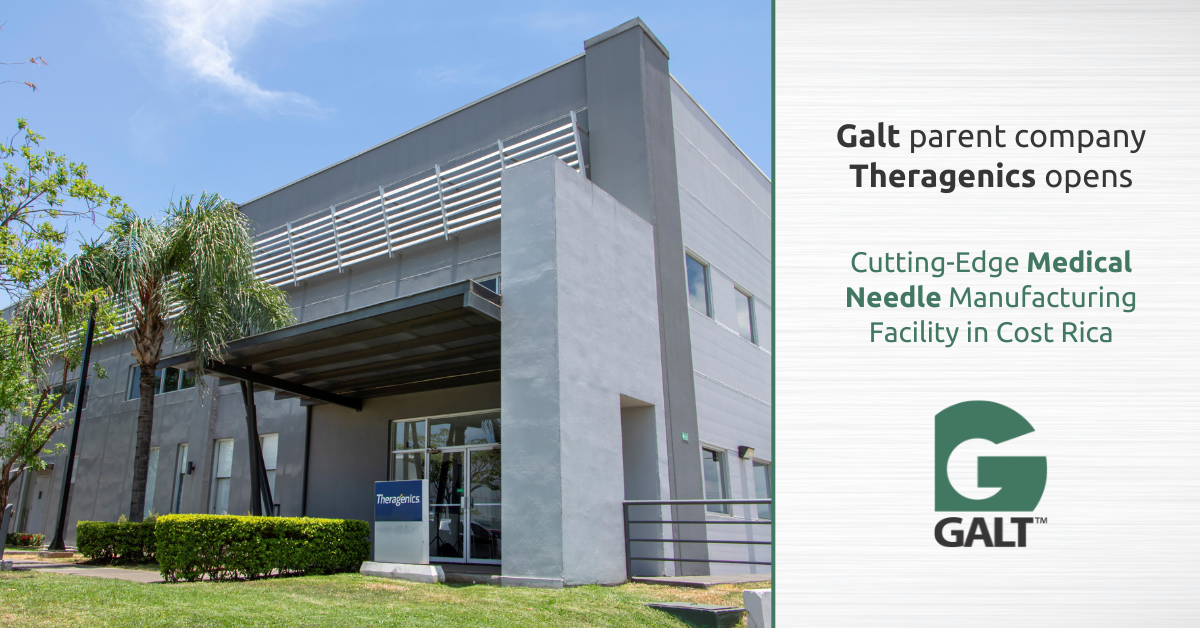Press Release: Theragenics, Galt’s Parent Company, Opens New Medical Needle Manufacturing Facility in Costa Rica

The state-of-the-art 4,000-square-meter facility will support medical device companies around the world.
Global medical device company Theragenics (parent company of Galt) today announced the grand opening of its new state-of-the-art medical manufacturing facility in Costa Rica. The 4,000-square-meter facility, located in the Coyol Free Zone, represents a USD$10 million investment and is expected to create over 500 new jobs.
This marks a significant milestone for Costa Rica, as it becomes the country’s first manufacturing facility dedicated to the production of specialized medical needles, guidewires, and related components.
“We are thrilled to officially open this cutting-edge facility,” said Mark Pugh, CEO of Theragenics Corporation. “The dedication and hard work of our team have brought us to this point ahead of schedule. This facility will play a vital role in supporting the global medical device industry by enabling the production of complex and innovative devices that improve patient outcomes.”
A Hub of Innovation
The new facility boasts a 2,000-square-meter production floor and a 1,000-square-meter cleanroom built to Class 8 standard, equipped with the latest manufacturing technologies. This advanced infrastructure will allow Theragenics to serve a diverse range of medical device companies, including OEMs and leading life sciences organizations worldwide.
“Costa Rica’s skilled workforce and thriving medical device ecosystem made it the ideal location for our new manufacturing facility,” continued Mr. Pugh. “We are proud to contribute to the country’s continued growth as a global leader in medical device manufacturing.”
Investing in the Future
Theragenics has a long-standing presence in Costa Rica and this investment further solidifies the company’s commitment to the region. The company is actively recruiting highly skilled professionals to join its growing team. Many new positions have already been filled, with these dedicated professionals actively contributing to projects alongside the existing Theragenics team.
As the new plant ramps up production, Theragenics will continue to recruit talented individuals across various medical device disciplines. “We are thrilled to welcome these skilled professionals to the Theragenics family,” said Mr. Pugh. “Their expertise will be invaluable as we bring this cutting-edge facility online and continue to deliver innovative solutions to the healthcare industry.”
The wider Theragenics group of companies has ambitious growth plans for 2025 and beyond. “This facility is a key component of Theragenics’ ambitious growth strategy,” concluded Mr. Pugh. “We are excited to contribute to the advancement of the global medical device industry and continue to deliver innovative solutions that improve patient lives.”
Ends.
About Theragenics
Theragenics (www.theragenics.com) is a leader in cutting-edge medical solutions, offering minimally invasive medical devices and radiation-based treatments that improve patient outcomes. Through our subsidiaries Arrotek (www.arrotek.com) and Galt (www.galtmedical.com), we design and deliver a broad range of vascular access devices, needles, catheters, guidewires, and more. We also partner with global medical device companies to provide comprehensive design, manufacturing, and regulatory support services.
.
.
